Introduction
With more than 18 lakh candidates vying for a career in various medical fields across India, only about 1.57 lakh have secured admission into the last year’s admission process through NEET 2024. This year’s exam was as competitive as ever for applicants wishing to study in any one of these prestigious institutions. The following sections focus on exam results; feedback from students and other stakeholders regarding top colleges followed by an insightful discussion about future trends.
NEET UG 2024: Setting the Stage
The NEET UG 2024 witnessed a surge in participation, reflecting the growing interest in medical education among Indian students.
- Total Participants: 18,72,000 (approx.)
- Qualifying Cut-off: General Category: 720 out of 720 (50th percentile) OBC/SC/ST: 635 out of 720 (40th percentile)
- Gender Distribution: Female candidates: 56% Male candidates: 44%
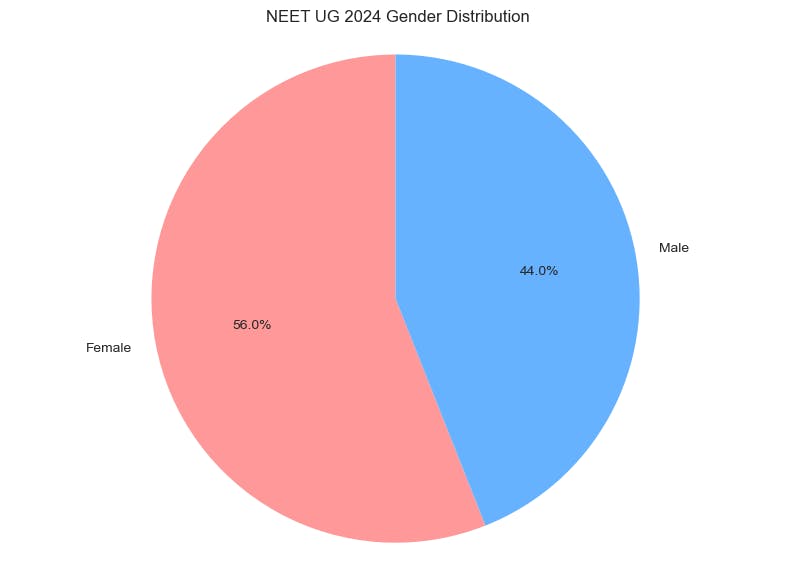
- Perfect Score (720/720) Achievers: 7 candidates
- State-wise Top Performers: Maharashtra Uttar Pradesh Delhi-NCR Tamil Nadu
Key Observations
- The increase in female participation continues, reflecting the growing interest in medical fields among girls.
- Urban centers dominated the top percentiles, highlighting the need for more robust preparation resources in semi-urban and rural areas.
- The competition has intensified, with the cut-off marks for the general category increasing by 15 points compared to the previous year.
Results Analysis
Score Distribution
- 700 and above: 1,250 candidates
- 650-699: 23,750 candidates
- 600-649: 1,15,000 candidates
- 500-599: 5,62,000 candidates
- 400-499: 7,80,000 candidates
- Below 400: 3,90,000 candidates
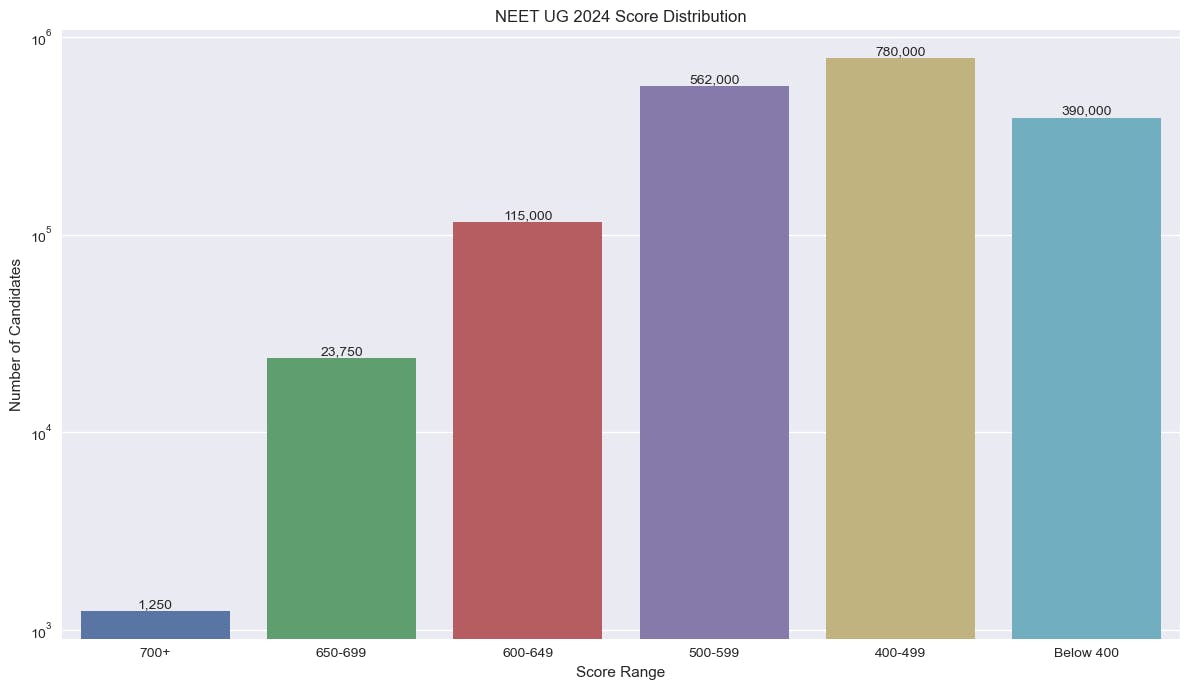
- General Category: Average score of 520
- OBC-NCL: Average score of 485
- SC: Average score of 460
- ST: Average score of 445
- EWS: Average score of 490
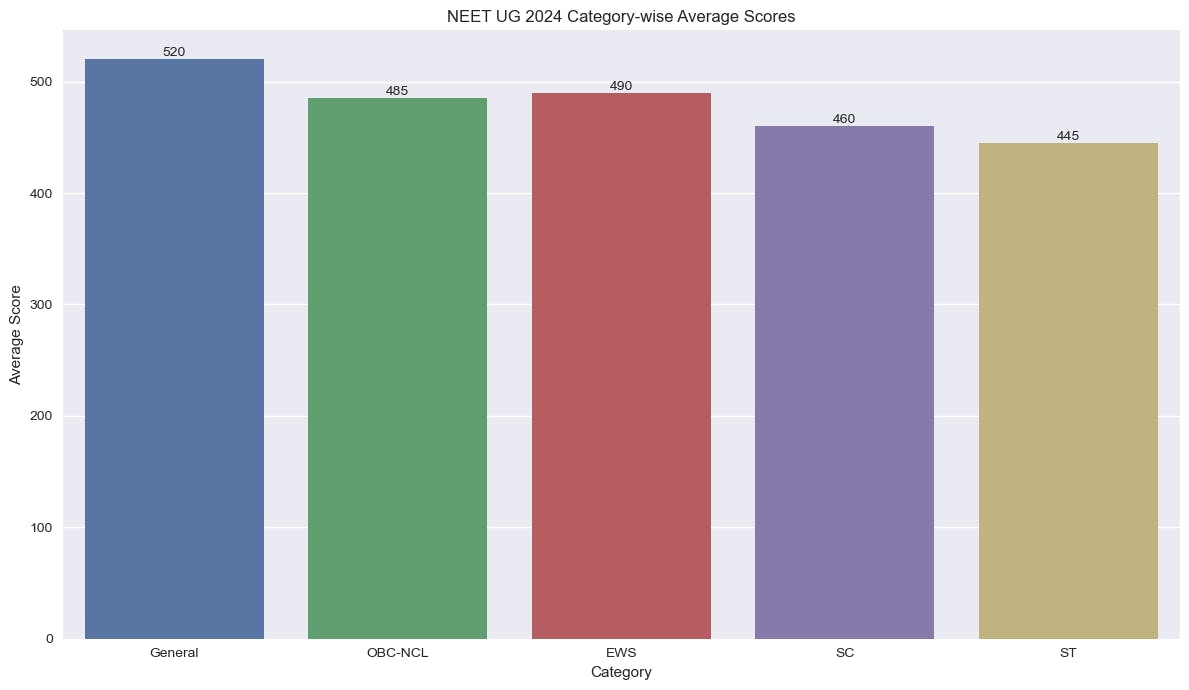
Analysis of Top Ranks
- AIR 1-100: Dominated by students from metro cities and established coaching hubs.
- AIR 101-1000: Saw a more diverse geographical representation, including tier-2 cities.
- Gender Distribution in Top 1000: Female: 54% Male: 46%
Seat Allocation: Top Medical Colleges and Universities
Overall Seat Distribution
The Medical Counselling Committee (MCC) managed the seat allocation process for All India Quota (AIQ) seats in government medical colleges, deemed universities, central universities, and ESIC institutes.
- Total MBBS Seats: 1,01,500 (approx.)
- Government College Seats: 54,000
- Private College Seats: 47,500
Top Government Medical Colleges and Their Seat Matrix
- All India Institute of Medical Sciences (AIIMS), New Delhi Total Seats: 125 Cut-off Range: AIR 1-150 Special Features: Advanced research facilities Integrated MD-PhD program
- Armed Forces Medical College (AFMC), Pune Total Seats: 150 Cut-off Range: AIR 100-500 Special Features: Military medical training Assured job placement in armed forces
- Maulana Azad Medical College, New Delhi Total Seats: 250 Cut-off Range: AIR 200-800 Special Features: Associated with multiple specialty hospitals Strong focus on community medicine
- King George's Medical University, Lucknow Total Seats: 250 Cut-off Range: AIR 300-1200 Special Features: Extensive alumni network Well-equipped trauma center
- Seth GS Medical College, Mumbai Total Seats: 200 Cut-off Range: AIR 250-1000 Special Features: Associated with the renowned KEM Hospital Strong emphasis on clinical exposure
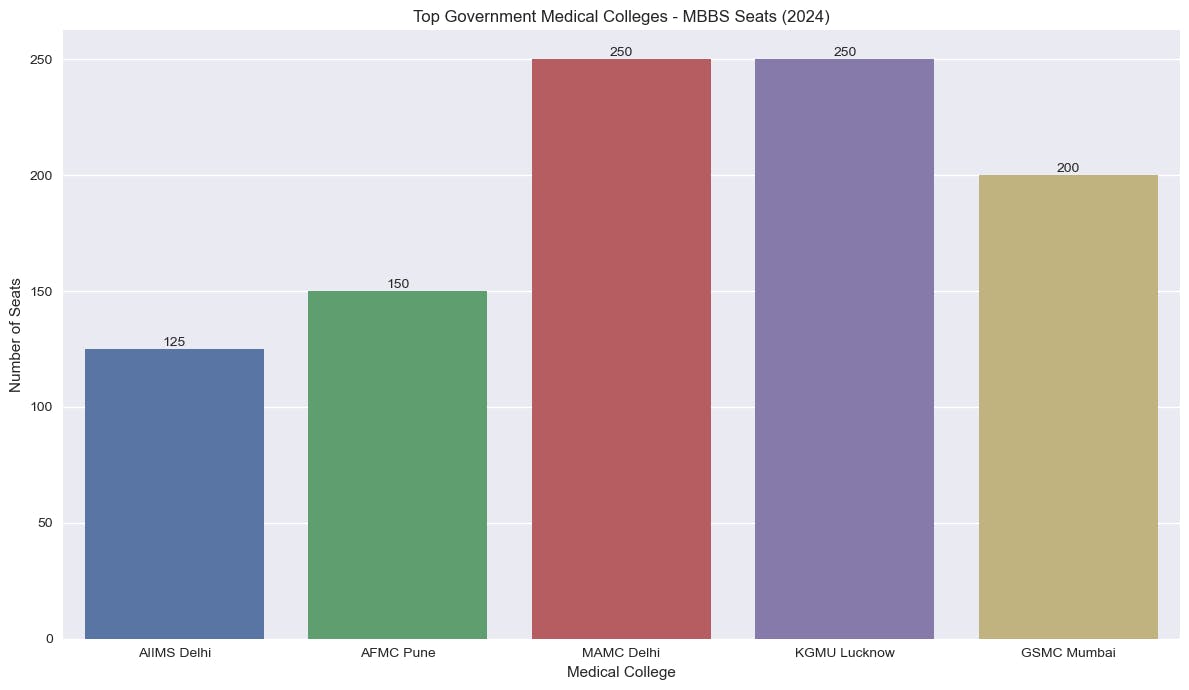
Top Private Medical Colleges and Their Seat Matrix
- Christian Medical College (CMC), Vellore Total Seats: 100 Cut-off Range: AIR 50-1500 (includes separate CMC entrance test) Annual Fees: ₹3,50,000 (approx.)
- Kasturba Medical College, Manipal Total Seats: 250 Cut-off Range: AIR 1000-5000 Annual Fees: ₹25,00,000 (approx.)
- St. John's Medical College, Bangalore Total Seats: 150 Cut-off Range: AIR 2000-8000 Annual Fees: ₹15,00,000 (approx.)
- D Y Patil Medical College, Pune Total Seats: 250 Cut-off Range: AIR 5000-20000 Annual Fees: ₹30,00,000 (approx.)
- Jawaharlal Nehru Medical College, Belgaum Total Seats: 200 Cut-off Range: AIR 8000-25000 Annual Fees: ₹12,00,000 (approx.)
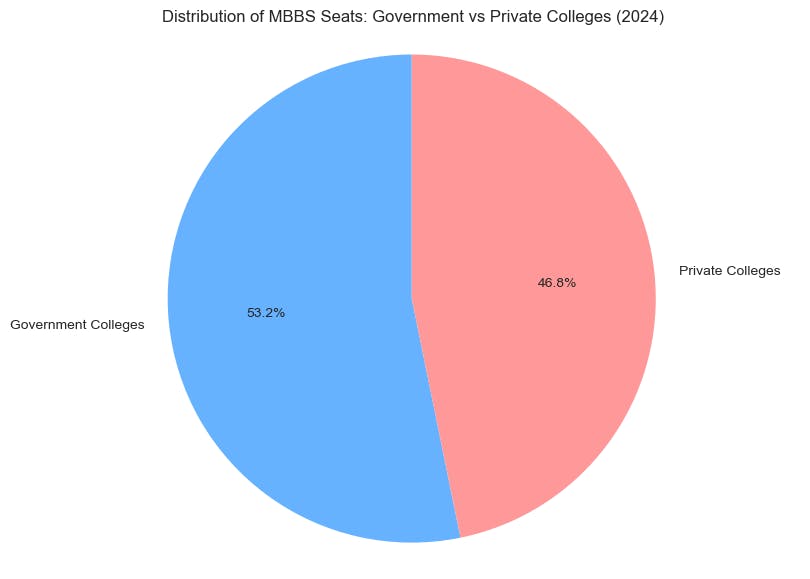
Emerging Medical Colleges
- AIIMS Rishikesh Total Seats: 100 Cut-off Range: AIR 500-2000 Special Focus: Mountain medicine and telemedicine
- JIPMER Karaikal Total Seats: 50 Cut-off Range: AIR 1000-3000 Special Focus: Rural health and tropical diseases
- IMS BHU, Varanasi Total Seats: 125 Cut-off Range: AIR 800-2500 Special Focus: Integrative medicine and Ayurveda research
Course-wise Seat Distribution and Trends
MBBS (Bachelor of Medicine, Bachelor of Surgery)
- Total Seats: 1,01,500
- Duration: 5.5 years (including 1-year internship)
- Key Features: Comprehensive medical education Exposure to various medical specialties Mandatory rural posting in many states
BDS (Bachelor of Dental Surgery)
- Total Seats: 27,000
- Duration: 5 years (including 1-year internship)
- Key Features: Focused on oral health and dentistry Growing demand due to increased awareness of dental care
AYUSH Courses
- BAMS (Bachelor of Ayurvedic Medicine and Surgery) Total Seats: 30,000 Duration: 5.5 years Focus: Traditional Indian medicine system
- BHMS (Bachelor of Homeopathic Medicine and Surgery) Total Seats: 12,000 Duration: 5.5 years Focus: Homeopathic treatment methods
- BUMS (Bachelor of Unani Medicine and Surgery) Total Seats: 7,000 Duration: 5.5 years Focus: Greco-Arabic medical system
Veterinary Sciences
- BVSc & AH (Bachelor of Veterinary Science & Animal Husbandry) Total Seats: 5,000 Duration: 5.5 years Focus: Animal health and welfare
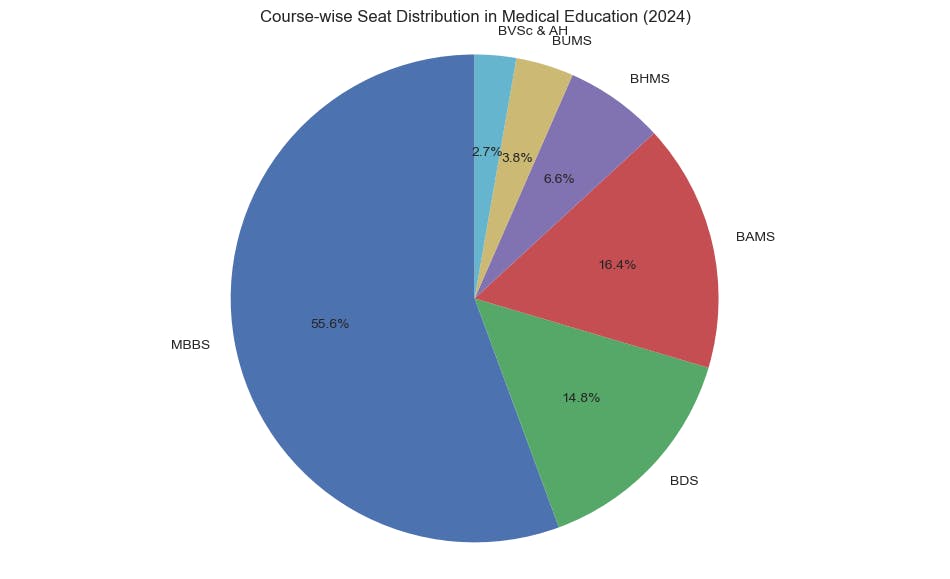
Factors Influencing Seat Allocation
Reservation Policy
The seat allocation in medical colleges follows the government-mandated reservation policy:
- General Category: 40.5%
- Other Backward Classes (OBC-NCL): 27%
- Scheduled Castes (SC): 15%
- Scheduled Tribes (ST): 7.5%
- Economically Weaker Sections (EWS): 10%
Additionally, there's a horizontal reservation of 5% for Persons with Disabilities (PwD) across all categories.
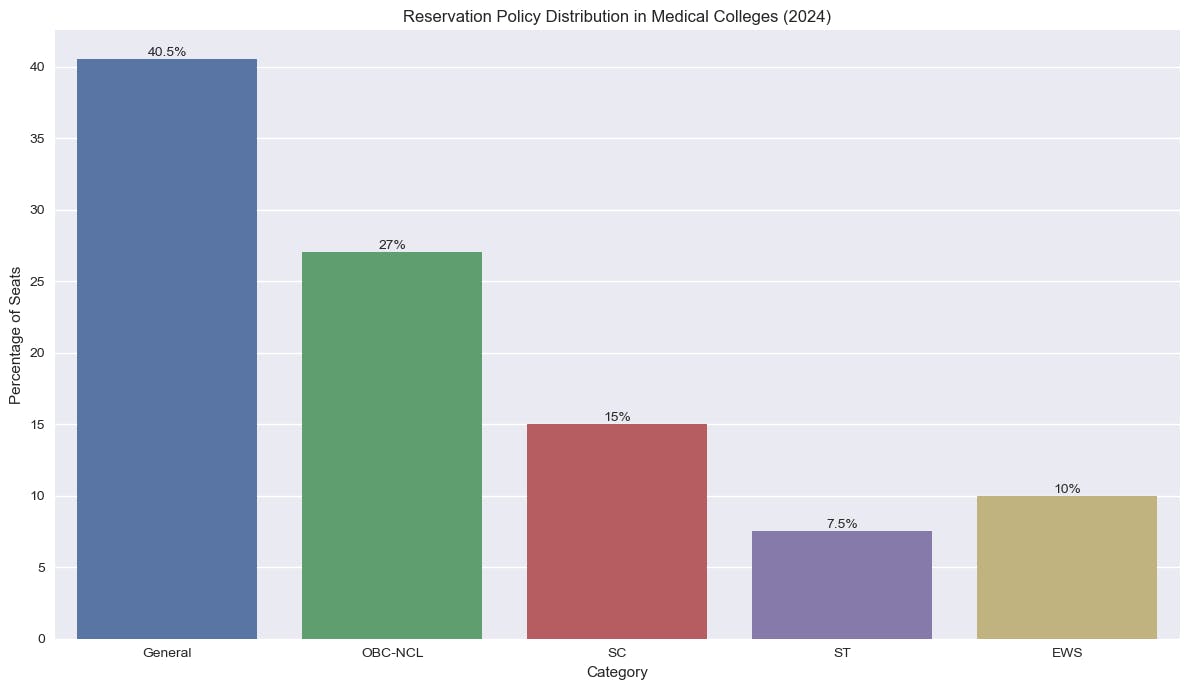
State Quota vs All India Quota
- 15% of seats in government medical colleges are allocated to the All India Quota (AIQ)
- 85% of seats are reserved for state quota (for students domiciled in the respective state)
Gender Diversity Initiatives
To promote gender balance in medical education, some states have implemented measures such as:
- Relaxation in cut-off percentages for female candidates
- Separate counseling rounds for female candidates
- Scholarships and financial aid programs for girl students
These efforts have shown positive results, with female enrollment in medical colleges increasing steadily over the years.
Counseling Process and Strategies
MCC Counseling Rounds
The Medical Counselling Committee conducts multiple rounds of counseling:
- Round 1: Main allocation round
- Round 2: For remaining vacant seats
- Mop-up Round: To fill any leftover seats
- Stray Vacancy Round: Final round for any remaining vacancies
Tips for Effective Counseling
- Research Thoroughly: Understand the placement records, faculty strength, and research opportunities of each institute.
- Be Realistic: Balance ambition with pragmatism when filling out choice lists.
- Consider Future Prospects: Look beyond immediate admissions to long-term career growth and specialization opportunities.
- Explore New Colleges: Don't overlook emerging AIIMS and other new government medical colleges, which often offer excellent infrastructure and faculty.
- Understand Fee Structures: Be aware of the financial commitments, especially for private colleges, including tuition, hostel fees, and other expenses.
Future Outlook and Career Prospects
Emerging Specializations
- Telemedicine and Digital Health
- Genomic Medicine and Personalized Healthcare
- Robotic Surgery and AI in Medicine
- Public Health and Epidemiology
- Geriatric Medicine
Career Paths Beyond Clinical Practice
- Medical Research and Clinical Trials
- Healthcare Management and Administration
- Medical Journalism and Communication
- Medicolegal Consultancy
- Pharmaceutical Industry and Drug Development
Conclusion
The NEET UG 2024 results and subsequent seat allocation process reflect the evolving landscape of medical education in India. The increasing competition, coupled with the expansion of medical seats and the emergence of new institutions, presents both challenges and opportunities for aspiring medical professionals.
As candidates navigate this complex ecosystem, it's crucial to make informed decisions based on individual interests, aptitudes, and long-term career goals. The journey through medical education is not just about securing a seat but about laying the foundation for a fulfilling and impactful career in healthcare.
The competitive nature of NEET UG and the diverse opportunities it presents underscore the need for thorough preparation, strategic decision-making, and a clear understanding of one's career aspirations. As India continues to position itself as a global healthcare hub, the role of these medical institutions in shaping the next generation of doctors and healthcare professionals becomes increasingly significant.
Aspiring medical students should look beyond the traditional notions of success and explore the wide array of opportunities that modern medical education offers. Whether it's cutting-edge research, community healthcare, or emerging fields like telemedicine, the medical profession in India is evolving rapidly, offering exciting prospects for those who are passionate about making a difference in people's lives.







